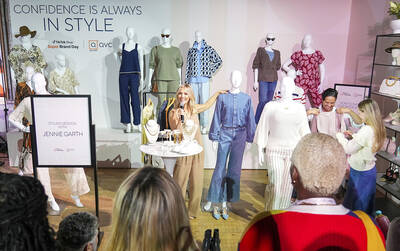It has been said that people do not want tablets, they want iPads.
For years, Amazon.com Inc, the online retail giant, has been trying to change that.
The company’s latest effort comes in a refresh of its Kindle tablets and e-readers, announced on Wednesday evening, with a set of internal hardware improvements and updated software features that Amazon hopes will woo new crowds to its line of devices.
Amazon’s strategy is to broaden its target market by offering a greater number of devices.
Take the updated Kindle Fire HDX 8.9 tablet. It now includes a powerful 2.5GHz Snapdragon processor from Qualcomm Inc and comes with the WPS Office app, essentially a way to create and edit documents from the tablet. The app is integrated with Amazon’s Cloud Drive, which backs up documents on Amazon’s servers. Amazon has also built a Fire Keyboard, which connects wirelessly to the HDX 8.9 tablet via Bluetooth.
The aim here, it seems, is to go after the segment of the market that wants to use a tablet as a workstation, instead of toting around a laptop. In other words, it is the same audience that Microsoft has tried to court with its Surface tablet.
“We have all the power and performance you need to multitask,” said Jonathan Oakes, a director of product management for Amazon, at a media event on Wednesday. “Now we are just making it easier to switch between all the things people want to do.”
The HDX will cost US$379, which is about the same price as Microsoft Corp’s Surface RT, depending on which model you buy.
However, modeling the new Kindle on the Surface is questionable, as the Surface has hardly flown off the shelves. Microsoft took a US$900 million write-down on unsold Surface RTs last year.
For what it is worth, the HDX also comes with a sound system upgrade, courtesy of Dolby, as well as improved graphics processing and a better display, which could appeal to media-hungry consumers. So it is not all about business.
Amazon is not just targeting adults. The Kindle Fire HD Kids Edition, for instance, is aimed at the opposite end of the market.
For US$149, Amazon offers an updated 6-inch Kindle Fire HD tablet with front and rear-facing cameras, an improved display and a better microprocessor. It also comes in an array of colors, much like Apple’s iPods.
However, the unique selling point is the guarantee that comes with the device. Up to two years after purchase, if the tablet gets broken, Amazon will replace it The shockproof rubber case that comes in the package will probably help protect against that too.
The device also allows for full access to “FreeTime Unlimited,” Amazon’s child-friendly section of videos, apps and games.
So for about US$50 more than the cost of a new Kindle Fire HD, the buyer is essentially purchasing an extended warranty for an impressive child’s toy.
Finally, for those who just want to read on their tablet, Amazon has updated its classic line of e-readers. The refresh includes a new US$79 Kindle — the lowest-price option — as well as a new high-end model, the Voyage, a thin, lightweight reader with an improved front light and touch-screen capability. The Voyage is not cheap; at US$199, it is Amazon’s most expensive e-reader.
Amazon’s fall line comes months before the holiday season, when manufacturers like Samsung Electronics Co, Lenovo Group Ltd (聯想) and Apple Inc will all push their tablets heavily on gift-seekers.

BYPASSING CHINA TARIFFS: In the first five months of this year, Foxconn sent US$4.4bn of iPhones to the US from India, compared with US$3.7bn in the whole of last year Nearly all the iPhones exported by Foxconn Technology Group (富士康科技集團) from India went to the US between March and last month, customs data showed, far above last year’s average of 50 percent and a clear sign of Apple Inc’s efforts to bypass high US tariffs imposed on China. The numbers, being reported by Reuters for the first time, show that Apple has realigned its India exports to almost exclusively serve the US market, when previously the devices were more widely distributed to nations including the Netherlands and the Czech Republic. During March to last month, Foxconn, known as Hon Hai Precision Industry

Taiwan Semiconductor Manufacturing Co (TSMC, 台積電) and the University of Tokyo (UTokyo) yesterday announced the launch of the TSMC-UTokyo Lab to promote advanced semiconductor research, education and talent development. The lab is TSMC’s first laboratory collaboration with a university outside Taiwan, the company said in a statement. The lab would leverage “the extensive knowledge, experience, and creativity” of both institutions, the company said. It is located in the Asano Section of UTokyo’s Hongo, Tokyo, campus and would be managed by UTokyo faculty, guided by directors from UTokyo and TSMC, the company said. TSMC began working with UTokyo in 2019, resulting in 21 research projects,

Ashton Hall’s morning routine involves dunking his head in iced Saratoga Spring Water. For the company that sells the bottled water — Hall’s brand of choice for drinking, brushing his teeth and submerging himself — that is fantastic news. “We’re so thankful to this incredible fitness influencer called Ashton Hall,” Saratoga owner Primo Brands Corp’s CEO Robbert Rietbroek said on an earnings call after Hall’s morning routine video went viral. “He really helped put our brand on the map.” Primo Brands, which was not affiliated with Hall when he made his video, is among the increasing number of companies benefiting from influencer

Quanta Computer Inc (廣達) chairman Barry Lam (林百里) yesterday expressed a downbeat view about the prospects of humanoid robots, given high manufacturing costs and a lack of target customers. Despite rising demand and high expectations for humanoid robots, high research-and-development costs and uncertain profitability remain major concerns, Lam told reporters following the company’s annual shareholders’ meeting in Taoyuan. “Since it seems a bit unworthy to use such high-cost robots to do household chores, I believe robots designed for specific purposes would be more valuable and present a better business opportunity,” Lam said Instead of investing in humanoid robots, Quanta has opted to invest